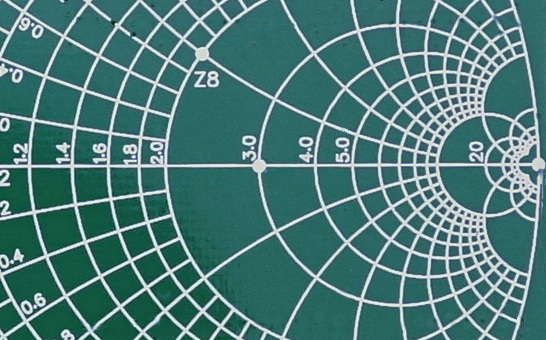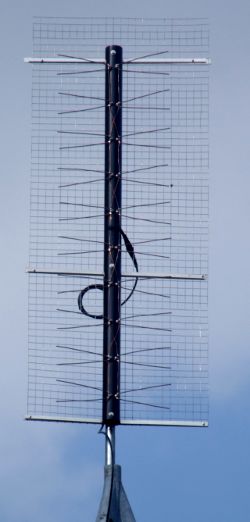 Since my TV antenna was damaged by an ice storm, I needed to build an HDTV antenna. While searching, I found some HDTV antenna builds that used coat hangers. Being 70 miles away from the HDTV stations, I definitely need my HDTV antenna to be outdoors. Coat hangers rust, and end up with bad connections which makes your HDTV antenna useless over time. In this post, I will show you how to build a HDTV antenna.
Since my TV antenna was damaged by an ice storm, I needed to build an HDTV antenna. While searching, I found some HDTV antenna builds that used coat hangers. Being 70 miles away from the HDTV stations, I definitely need my HDTV antenna to be outdoors. Coat hangers rust, and end up with bad connections which makes your HDTV antenna useless over time. In this post, I will show you how to build a HDTV antenna.
 Additionally, the HDTV antenna builds I have seen don’t seem to have the long range that I need, such as the DB4. So I have come up with a modified version that works well in HDTV fringe areas. The photo on the left is my HDTV antenna that I built. I have also seen where people will take two HDTV DB4 antennas and gang them and then use a splitter / combiner to feed the HDTV antennas. Although this seems to work, my thinking is that adding a second antenna typically yields 3 db of gain. However a splitter / combiner has a 3 db insertion loss. Which is spelled out on the splitter’s package. It seems to me that you are losing what you have gained in ganging two DB4 antennas. My HDTV antenna build eliminates the need to use a splitter / combiner.
Additionally, the HDTV antenna builds I have seen don’t seem to have the long range that I need, such as the DB4. So I have come up with a modified version that works well in HDTV fringe areas. The photo on the left is my HDTV antenna that I built. I have also seen where people will take two HDTV DB4 antennas and gang them and then use a splitter / combiner to feed the HDTV antennas. Although this seems to work, my thinking is that adding a second antenna typically yields 3 db of gain. However a splitter / combiner has a 3 db insertion loss. Which is spelled out on the splitter’s package. It seems to me that you are losing what you have gained in ganging two DB4 antennas. My HDTV antenna build eliminates the need to use a splitter / combiner.
Its surprising the number of people that think that in order to get HDTV stations, you have to have cable. This is not true, as TV stations still transmit their signal in what is called Over the air – OTA. So if you live within say, 70 miles of a TV station, you might be able to receive HDTV over the air too, and eliminate your cable bill.
I cut cable about two years ago and made an antenna (inside) similar to the one posts using copper wire as clothes hangers attached . on a thin piece of wood . I am able to get 39 channels. It truly worked better than the Purchased antenna.When my grandson saw how well it worked he was amazed and had that can you make me one on his face. Now that I see your model , I’m wondering if I up grade mine with wire and pipe as yours if it may be more effective.
Hello,
The more elements that the antenna has the more gain it will have. Which will allow you a greater range. So if your antenna you built has less elements than mine, then adding elements will increase the gain of the antenna and will increase its range.
Good luck!
— Mike WB8ERJ
How did you mount to your roof
Hello,
I have a 30 foot tower that I mounted it on.
would this work in an attic?
B
Yes, but not as good as if it was outside. This antenna is somewhat tall. Something close to 8 feet.
Good luck!
Where’s the wire going to the TV set?
Ah! Good question! It seems that I didn’t put in the text on page 7. If you look at the diagram showing the layout of the phasing harness, in the center is a black dot. That is where you connect the feed point, which is 300 ohms. Since most people use coax (recommended..) you will need to connect a CATV transformer. Otherwise known as a CATV balun. Then run your Coax down to the TV.
Good catch! I will update page 7 to properly answer your question.
— Mike WB8ERJ
Any chance you could provide a picture of the balun connection? Is a simple 75 to 300 Ohm transformer (like this: https://www.parts-express.com/75-to-300-Ohm-Matching-Transformer-180-010?quantity=1) what you used? Where did you source the animal fencing?
Hello,
Sorry, I don’t have a picture of the balun connection. Yes, the balun is a simple 75 to 300 ohm transformer like the one you link. They can be found pretty much anywhere. Walmart, Home Depot etc.
As far as the fencing, I picked min up at Tractor Supply. Any farm type supply stor will have it.
Does this pick up both VHF and UHF frequencies? What sort of gain do you observe with VHF and with UHF frequencies?
Since the move to HDTV, all TV channels are UHF even though the old VHF channels kept their original channel numbers.
As far as gain observed, I have no way of measuring TV antenna gain. What I can tell you is that my HDTV antenna is on top of a 30 foot tower and I get a clear picture from several stations 70 miles away.
Hope this helps! — Mike
I’m very interested in the antenna since analog tv broadcasts have ended in my country.
But ‘imperial’ sizes are as good as unknown in Europe.
Okay I know 1 inch = 1 thumb and equals 3,54 cm
1 ft = 30,48 cm
more difficult is the thickness of the copper wire, so what is ‘ga’ ?
The balun or transformer seems difficult to find here, how does it look like ?
Who helps ?
Hello, thanks for reading my blog.
First of all, 1 inch = 2.54 cm instead of 3.54 cm like you mentioned. My guess is its just a mis-typing, but I wanted to be clear.
You make a good point about Imperial sizes, especially about wire size. Below I have listed the wire diameters in mm for you.
6ga wire = 4.11 mm
14ga wire = 1.63 mm
These wire sizes aren’t critical. The main reason for using the 4.11 mm wire for the elements is so it can withstand high winds without bending.
As far as the balun, here is an amazon link with a photo and a description – the balun needs to be UHF frequency range.
https://www.amazon.com/Philmore-Outdoor-Antenna-Matching-Transformer/dp/B01B1VSCK6
Hope this helps! Good luck!
— Mike WB8ERJ
This design seems directional. I live in the middle of towers that are about the same distance apart. Linn Creek, MO 65052. Is there something you can recommend that is multi directional or can I put the same design on the backside of the reflectors?
Thanks for your time Stephen Houska.
Hello, yes, this is very directional. In order to pick up stations from different directions you will need an antenna rotor to rotate in the direction of the station you want to receive.
I wonder if galv. fencing could be rolled into a cylinder and used for antenna elements?
I kind of doubt it.
Can you connect multiple antennas to each other to compensate for having to aim in different directions?
Hello, I suppose you could. I’m not sure how well it would work out though. Honestly a better solution is to use an antenna rotator.
Hi,
I am thinking of doing this for a attic location. I would like to use 1/2″ square hardware cloth for my reflector. Would I still need the 2-1/2″ spacing to the elements or would this change for the 1/2″ square holes?
Yes you would still need the 2 1/2 inch spacing to the elements.The hardware cloth would probably be a better reflector than what I used. I decided against hardware cloth because my HDTV antenna is outside and subject to high winds.